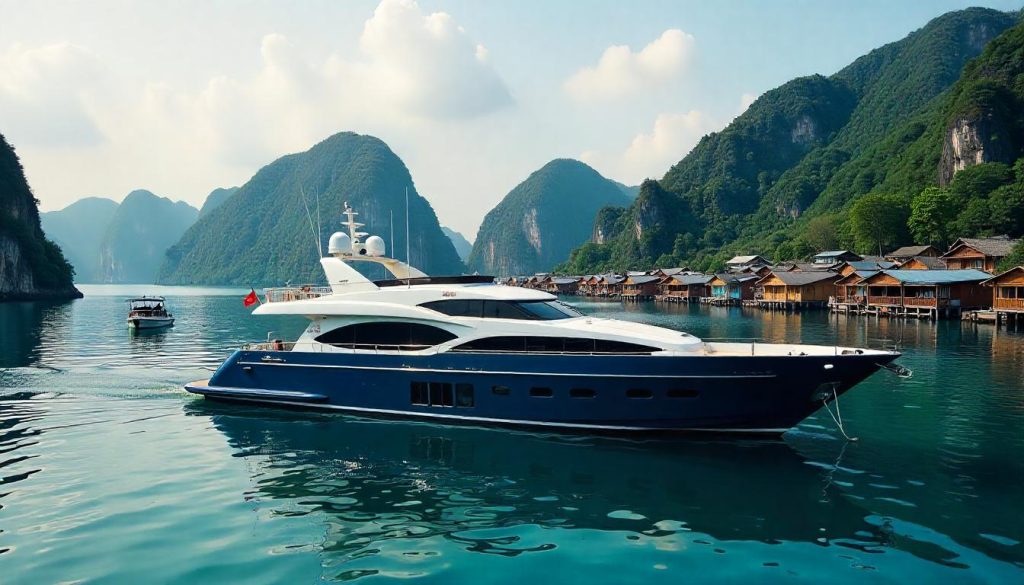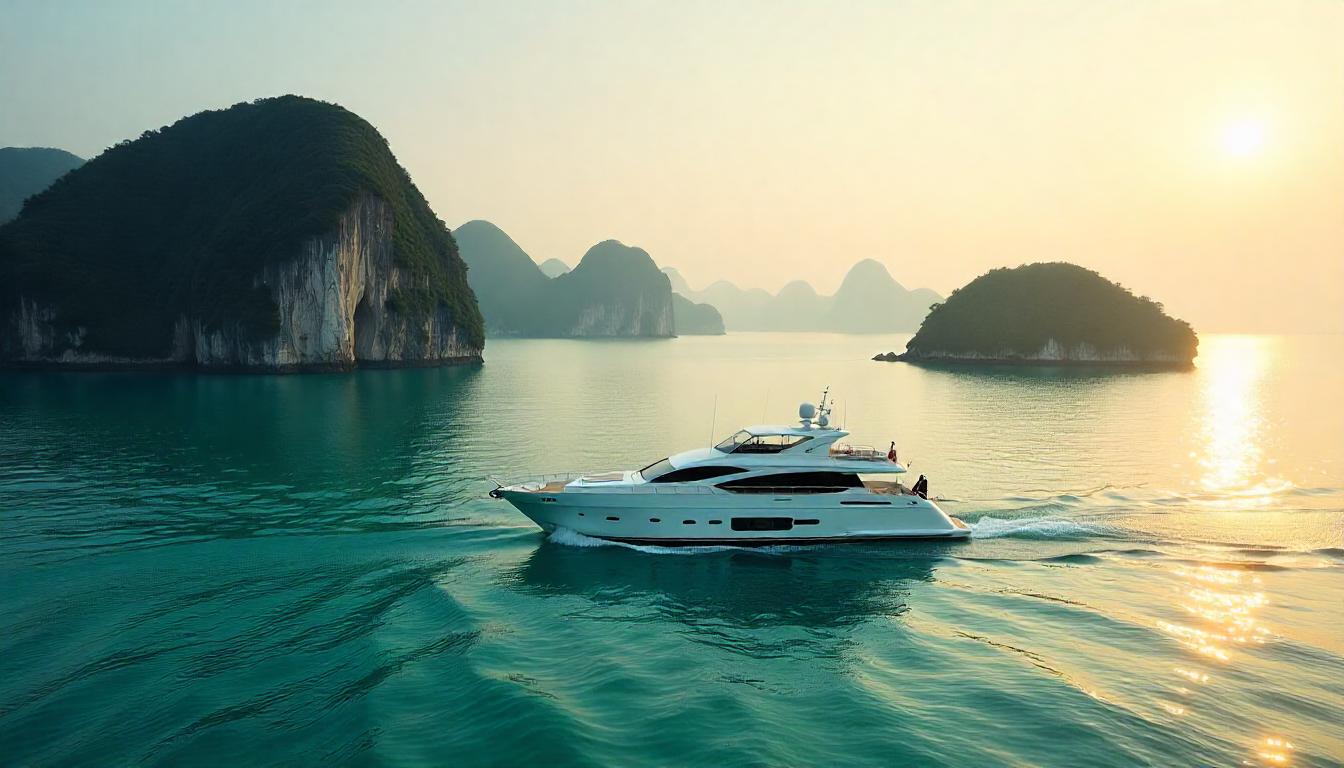Halong Bay, a UNESCO World Heritage site in northern Vietnam, is a breathtaking destination for sailors, and yachting in Vietnam Halong Bay in 2025 offers an extraordinary journey through its limestone wonders and emerald waters. With over 1,600 islands and islets, many of which are uninhabited, this bay provides a surreal landscape of karsts, caves, and floating villages. The calm waters and rich biodiversity make it a perfect spot for a yachting adventure, blending natural beauty with cultural immersion. In this article, we’ll explore the best routes, anchorages, and experiences that make yachting in Vietnam Halong Bay a must for adventurers. Let’s set sail and discover this Vietnamese gem.
Yachting in Vietnam Halong Bay: The Limestone Karsts
The limestone karsts of Halong Bay are the defining feature of this yachting destination, creating a dramatic seascape that feels otherworldly. These towering formations, sculpted by millions of years of erosion, rise sharply from the water, often cloaked in lush greenery. For example, you can sail through the bay’s central area near Dau Go Island, where karsts like Fighting Cock Islet, with its rooster-shaped rock, stand as natural sculptures. Also, the calm waters allow for easy navigation, with plenty of space to anchor and admire the scenery. Moreover, the karsts are home to hidden caves and grottoes, waiting to be explored by tender. Thus, the limestone karsts make Halong Bay a unique yachting experience.
Fighting Cock Islet: A Natural Icon
Fighting Cock Islet, also known as Hon Ga Choi, is a natural icon in Halong Bay. For instance, this limestone formation resembles two roosters facing each other, a shape that becomes even more striking at sunrise when the light casts a golden glow on the rocks. Also, the islet is a popular spot for photography, with yachters often anchoring nearby to capture the scene. Additionally, the surrounding waters are calm, making it a great place for a morning swim or paddleboarding. This iconic landmark adds a touch of whimsy to your journey. Therefore, it’s a must-see for sailors exploring Halong Bay.
Sung Sot Cave: A Hidden Marvel
Sung Sot Cave, or Surprise Cave, offers a hidden marvel for yachters in Halong Bay. For example, this massive cave on Bo Hon Island features three chambers filled with stalactites and stalagmites, illuminated by soft lighting to highlight their shapes. Also, a guided tour takes you through the cave’s pathways, revealing formations that resemble animals and mythical figures. Moreover, the cave’s entrance offers panoramic views of the bay, with karsts stretching into the distance. This natural wonder makes Sung Sot Cave a highlight. Thus, it’s a perfect excursion for sailors seeking adventure.
Floating Villages: A Cultural Encounter
Halong Bay’s floating villages provide a cultural encounter for those yachting in Vietnam Halong Bay, offering a glimpse into the lives of local fishing communities. These villages, built on rafts and boats, have thrived for generations, adapting to the bay’s unique environment. For instance, Cua Van Floating Village, one of the largest, is home to over 200 families who live on the water, fishing and farming oysters for pearls. Also, you can visit the village by tender, where locals often welcome visitors with fresh seafood and handmade crafts. Additionally, the Cua Van Floating Cultural Center showcases the history and traditions of the community. Therefore, the floating villages add a cultural depth to your yachting journey.
Cua Van Village: A Living Tradition
Cua Van Floating Village is a living tradition in Halong Bay. For example, the village’s colorful houses, floating on bamboo rafts, create a vibrant scene against the backdrop of limestone karsts. Also, you can interact with locals, who may invite you to try rowing a traditional bamboo boat or share stories of life on the water. Moreover, the village’s school, also floating, serves as a reminder of the community’s resilience and adaptability. This cultural immersion makes Cua Van a standout. Thus, it’s a must-visit for yachters seeking to connect with Halong Bay’s heritage.
Pearl Farming: A Local Craft
Pearl farming is a local craft in Halong Bay’s floating villages. For instance, many families cultivate oysters to produce pearls, a tradition passed down through generations. Also, you can visit a pearl farm to see the process, from seeding the oysters to harvesting the pearls, often followed by a chance to purchase jewelry. Additionally, the farmers share insights into the challenges of pearl farming, such as maintaining water quality and protecting oysters from disease. This hands-on experience adds a unique element to your journey. Therefore, pearl farming is a fascinating stop for sailors exploring the bay.

Cat Ba Island: Nature and Adventure
Cat Ba Island, the largest island in Halong Bay, offers nature and adventure for those yachting in Vietnam Halong Bay, blending rugged landscapes with outdoor activities. As part of the Cat Ba Archipelago, this island is a gateway to both Halong Bay and the adjacent Lan Ha Bay. For example, you can anchor in Ben Beo Harbour and explore Cat Ba National Park, a UNESCO Biosphere Reserve with hiking trails through dense forests and limestone peaks. Also, the island’s Monkey Island Beach is a great spot for swimming, with playful monkeys often spotted in the trees. Moreover, Cat Ba’s seafood restaurants serve fresh dishes like grilled squid and crab hotpot. Thus, Cat Ba Island provides a mix of adventure and relaxation for yachters.
Cat Ba National Park: A Hiker’s Paradise
Cat Ba National Park is a hiker’s paradise on Cat Ba Island. For instance, the park’s trails, like the one to Ngu Lam Peak, offer stunning views of the island’s karsts and the surrounding bays, with opportunities to spot wildlife like the endangered Cat Ba langur. Also, the park’s biodiversity includes over 1,500 plant species and rare birds like the white-headed langur. Additionally, guided tours are available, providing insights into the park’s conservation efforts and ecological importance. This natural escape makes Cat Ba National Park a highlight. Therefore, it’s a must-visit for sailors seeking outdoor adventure.
Monkey Island Beach: A Playful Stop
Monkey Island Beach on Cat Ba Island is a playful stop for yachters. For example, the beach’s golden sand and clear waters make it ideal for swimming and kayaking, with limestone cliffs providing a dramatic backdrop. Also, the beach is named for its resident monkeys, who often come down from the trees to interact with visitors, though feeding them is discouraged to protect their health. Moreover, a short hike to the island’s summit offers panoramic views of Halong Bay and Lan Ha Bay. This fun and scenic spot makes Monkey Island Beach a standout. Thus, it’s a great place for sailors to unwind.
Lan Ha Bay: A Quieter Alternative
Lan Ha Bay, located south of Halong Bay, offers a quieter alternative for those yachting in Vietnam Halong Bay, with similar limestone karsts but fewer crowds. Often considered an extension of Halong Bay, Lan Ha Bay is part of the Cat Ba Archipelago and features over 400 islands. For instance, you can sail through the bay’s calm waters and anchor near Cai Beo Floating Village, one of the oldest fishing communities in Vietnam. Also, the bay’s Dark and Bright Cave, accessible by kayak, features a tunnel leading to a hidden lagoon surrounded by cliffs. Additionally, Lan Ha Bay’s beaches, like Van Boi, provide secluded spots for swimming and sunbathing. Therefore, Lan Ha Bay offers a peaceful escape for yachters.
Dark and Bright Cave: A Kayaking Adventure
Dark and Bright Cave in Lan Ha Bay offers a kayaking adventure for yachters. For example, the cave’s narrow tunnel, only accessible at low tide, leads to a serene lagoon where the water glows emerald green under the sunlight. Also, the surrounding cliffs are home to birds like kingfishers, adding to the natural ambiance. Moreover, kayaking through the cave provides a sense of exploration, with stalactites hanging overhead and the sound of dripping water echoing in the darkness. This adventurous experience makes Dark and Bright Cave a highlight. Thus, it’s a must-do for sailors seeking a unique activity.
Van Boi Beach: A Secluded Retreat
Van Boi Beach in Lan Ha Bay is a secluded retreat for yachters. For instance, the beach’s soft sand and shallow waters make it perfect for swimming, with minimal waves ensuring a calm experience. Also, the beach is surrounded by limestone karsts and dense jungle, creating a private oasis away from the busier parts of Halong Bay. Additionally, the lack of development means you’ll likely have the beach to yourself, ideal for a quiet picnic or a sunset yoga session. This peaceful setting makes Van Boi Beach a standout. Therefore, it’s a perfect spot for sailors seeking solitude.
Practical Tips for Yachting in Vietnam Halong Bay
Yachting in Vietnam Halong Bay requires careful planning to ensure a smooth and enjoyable trip in 2025. For example, the best time to sail is between October and April, when the weather is cooler and drier, with temperatures ranging from 15°C to 25°C, and the seas are calm. Also, hiring a local crew familiar with Halong Bay’s waters can help you navigate narrow channels and avoid crowded areas. Moreover, booking anchorages in advance, especially during peak seasons like Tet (Vietnamese Lunar New Year), ensures a hassle-free experience. Additionally, packing lightweight clothing, a rain jacket, and reef-safe sunscreen is essential for Vietnam’s climate. Therefore, preparation is key to a successful yachting adventure.
Best Time to Sail in Halong Bay
Timing your yachting trip can enhance your experience in Halong Bay. For instance, the dry season from October to April offers pleasant weather with clear skies, ideal for sailing and exploring caves. Also, the summer months, from May to September, bring higher temperatures and occasional rain, but also fewer crowds and lush greenery. Moreover, events like the Halong Carnival in April add a cultural highlight with parades and fireworks. This variety allows you to choose based on your preferences. Thus, understanding the seasons helps you plan the perfect trip.
Navigating Halong Bay’s Waters Safely
Navigating Halong Bay’s waters requires attention to ensure safety. For example, the bay’s limestone karsts and shallow areas, particularly around crowded spots like Sung Sot Cave, demand vigilance, so updated charts and GPS apps are essential. Also, many charters provide experienced crews who know the local waters well. Additionally, checking weather forecasts daily helps you avoid sudden storms, especially during the rainy season. This preparation keeps your journey smooth. Therefore, proper navigation tools are crucial for a worry-free experience.
Conclusion: Yachting in Vietnam Halong Bay in 2025
Yachting in Vietnam Halong Bay in 2025 offers an unforgettable journey through limestone wonders, hidden caves, and vibrant floating villages. From the iconic karsts of Fighting Cock Islet to the serene beaches of Lan Ha Bay, each stop provides a unique perspective on this UNESCO site. Also, the region’s cultural encounters and natural beauty make it a sailor’s paradise. Whether you’re kayaking through Dark and Bright Cave or hiking in Cat Ba National Park, Halong Bay delivers memories that last a lifetime. Therefore, set sail and discover the magic of this Vietnamese gem through a yachting adventure.

 الإبحار باليخوت في فيتنام: استكشاف عجائب الحجر الجيري في خليج هالونج">
الإبحار باليخوت في فيتنام: استكشاف عجائب الحجر الجيري في خليج هالونج">
